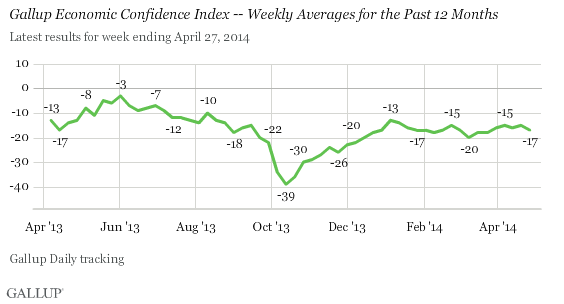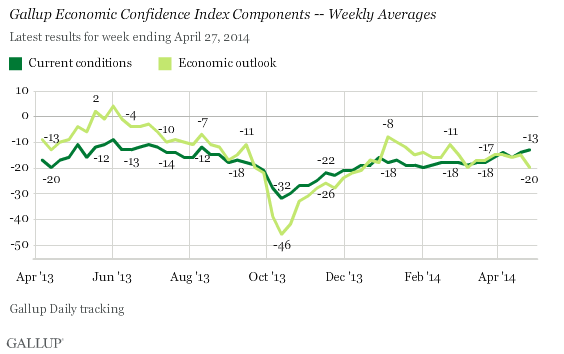WASHINGTON, D.C. -- Gallup's Economic Confidence Index averaged -17 for the week ending April 27. This represents a slight drop from consistent index ratings of either -15 or -16 for the past four weeks.

Economic confidence was similarly low in April 2013 but began rising to an all-time high of -3 in late May. Confidence then slowly receded through the end of the summer before falling sharply to -39 in October during the partial government shutdown. After the shutdown, confidence gradually improved through the end of 2013.
The index has been relatively stable so far in 2014, with weekly averages ranging between -13 and -20 and not changing by more than three points in any week.
More Americans Say the Economy Is Getting Worse
Gallup's Economic Confidence Index is the average of two components: how Americans rate current economic conditions, and their views on whether the economy is getting better or worse. Over the past few weeks, the scores on the two components have been similar. However, this week they diverged sharply, with a seven-point difference between them. While Americans' ratings of current economic conditions are a bit more positive, they are slightly more likely to say the economy is getting worse.

This week, 20% of Americans say the economy is "excellent" or "good," while 33% rate it as "poor." This results in a current conditions score of -13, the most positive score since last August.
At the same time, 37% of Americans say the economy is getting better, while 57% say it is getting worse, resulting in an economic outlook score of -20. This is down from -15 the prior week and matches the 2014 low of -20 in early March. The outlook score has not been lower since last December.
Implications
Economic confidence has been fairly stable in the U.S. throughout 2014, although the current index rating represents its lowest point in the past month. This drop is attributable to a decline in Americans' outlook for the economy, even as their perceptions of current conditions have improved slightly.
Gallup.com reports results from these indexes in daily, weekly, and monthly averages and in Gallup.com stories. Complete trend data are always available to view and export in the following charts:
Daily: Economic Confidence
Weekly: Economic Confidence
Read more about Gallup's economic measures.
View our economic release schedule.
Survey Methods
Results for this Gallup poll are based on telephone interviews conducted April 21-27, 2014, on the Gallup Daily tracking survey, with a random sample of 3,554 adults, aged 18 and older, living in all 50 U.S. states and the District of Columbia.
For results based on the total sample of national adults, the margin of sampling error is ±3 percentage points at the 95% confidence level.
Interviews are conducted with respondents on landline telephones and cellular phones, with interviews conducted in Spanish for respondents who are primarily Spanish-speaking. Each sample of national adults includes a minimum quota of 50% cellphone respondents and 50% landline respondents, with additional minimum quotas by time zone within region. Landline and cellular telephone numbers are selected using random-digit-dial methods. Landline respondents are chosen at random within each household on the basis of which member had the most recent birthday.
Samples are weighted to correct for unequal selection probability, nonresponse, and double coverage of landline and cell users in the two sampling frames. They are also weighted to match the national demographics of gender, age, race, Hispanic ethnicity, education, region, population density, and phone status (cellphone only/landline only/both, and cellphone mostly). Demographic weighting targets are based on the most recent Current Population Survey figures for the aged 18 and older U.S. population. Phone status targets are based on the most recent National Health Interview Survey. Population density targets are based on the most recent U.S. census. All reported margins of sampling error include the computed design effects for weighting.
In addition to sampling error, question wording and practical difficulties in conducting surveys can introduce error or bias into the findings of public opinion polls.
For more details on Gallup's polling methodology, visit www.gallup.com.
